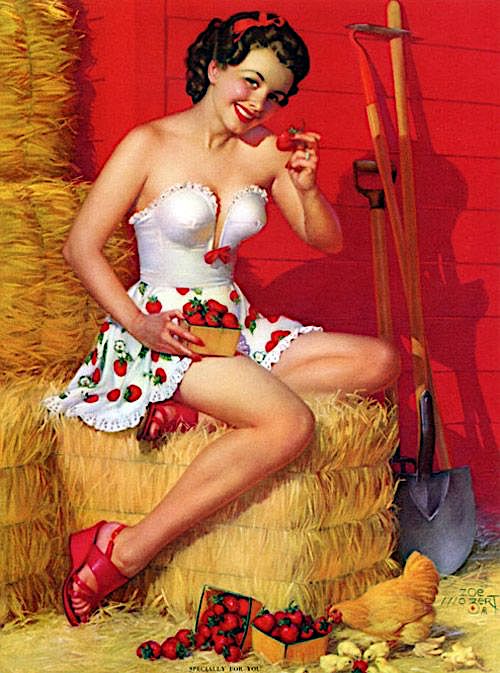IN THIS ISSUE
RENNES IN BRITTANY
By John Mariani
NEW YORK CORNER
LE PAVILLON
By John Mariani
CAPONE'S GOLD
CHAPTER NINETEEN
By John Mariani
NOTES FROM THE WINE CELLAR
NEW SPIRITS IN THE SUMMER MARKET
By John Mariani
❖❖❖
 On this week's
episode of my WVOX Radio Show "Almost
Golden," on
On this week's
episode of my WVOX Radio Show "Almost
Golden," on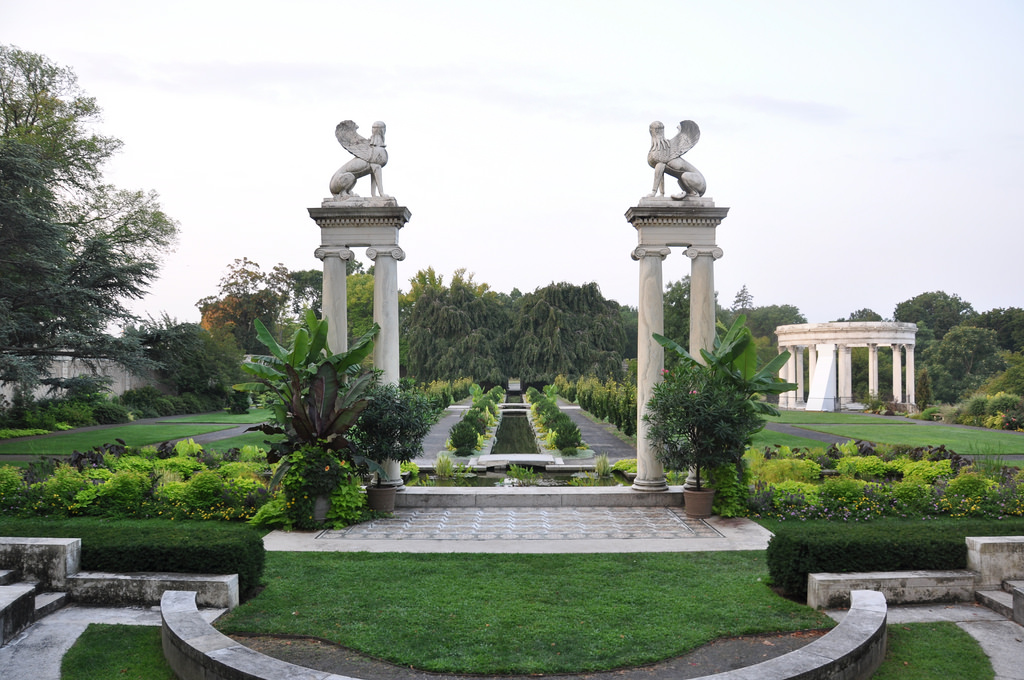 Wed. August
11 at 11AM EDT,I will be
interviewing Stephen Byrnes, director of
the Untermeyer Park Conservatory
in Yonkers, NY. Go to: WVOX.com.
The episode will also be archived at: almostgolden.
Wed. August
11 at 11AM EDT,I will be
interviewing Stephen Byrnes, director of
the Untermeyer Park Conservatory
in Yonkers, NY. Go to: WVOX.com.
The episode will also be archived at: almostgolden.❖❖❖
PUMMELED BY HISTORY, RENNES IS
NOW BRITTANY'S CULTURE CITY
By John Mariani
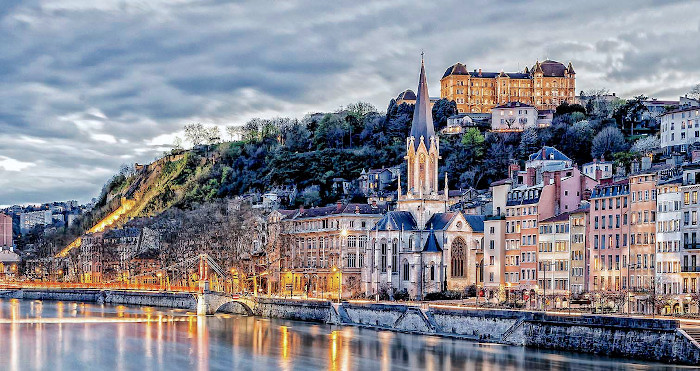
Rennes has been tucked into
northwestern Brittany for two millennia, yet it
only became a city of any real significance
after World War II. It was a quiet regional town
until 1720, when its largely wooden timbered
structures burned to the ground in a fire, and
even a century later its population was below
50,000 people. It took World War II to shake
Rennes into the 20th century after the Germans
occupied Rennes in 1940, and the Allies took it
back in 1944. Owing to it being a transport hub
in France, the city was bombed by both factions
into 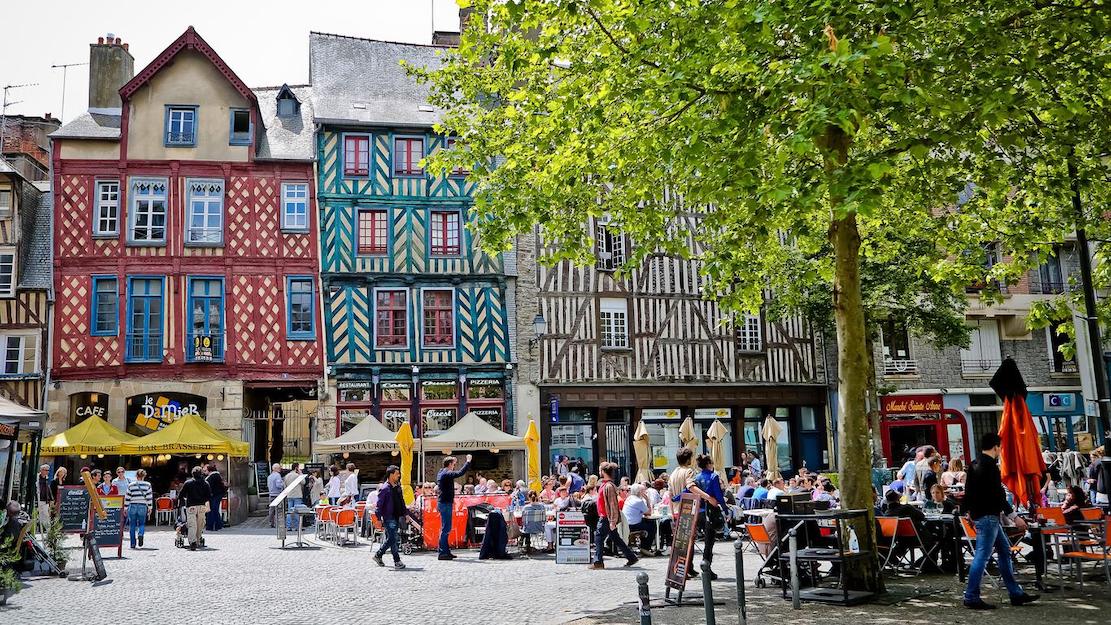 submission
with great destruction. After the war the city
fathers were smart to re-cast its future as a
cultural center for tourism so that while its
architecture appears Gothic, it is mostly new
and the destroyed wooden buildings were replaced
with other materials.
submission
with great destruction. After the war the city
fathers were smart to re-cast its future as a
cultural center for tourism so that while its
architecture appears Gothic, it is mostly new
and the destroyed wooden buildings were replaced
with other materials.
Now Rennes is a beautiful river city of
about 218,000 people. It is well laid out and
tidy, and when you enter the Old City gate called
Porte Mordelaise,
a small section of the oldest quarter is
still intact around Place Saint-Anne, with old,
sometimes leaning, half-timbered houses. 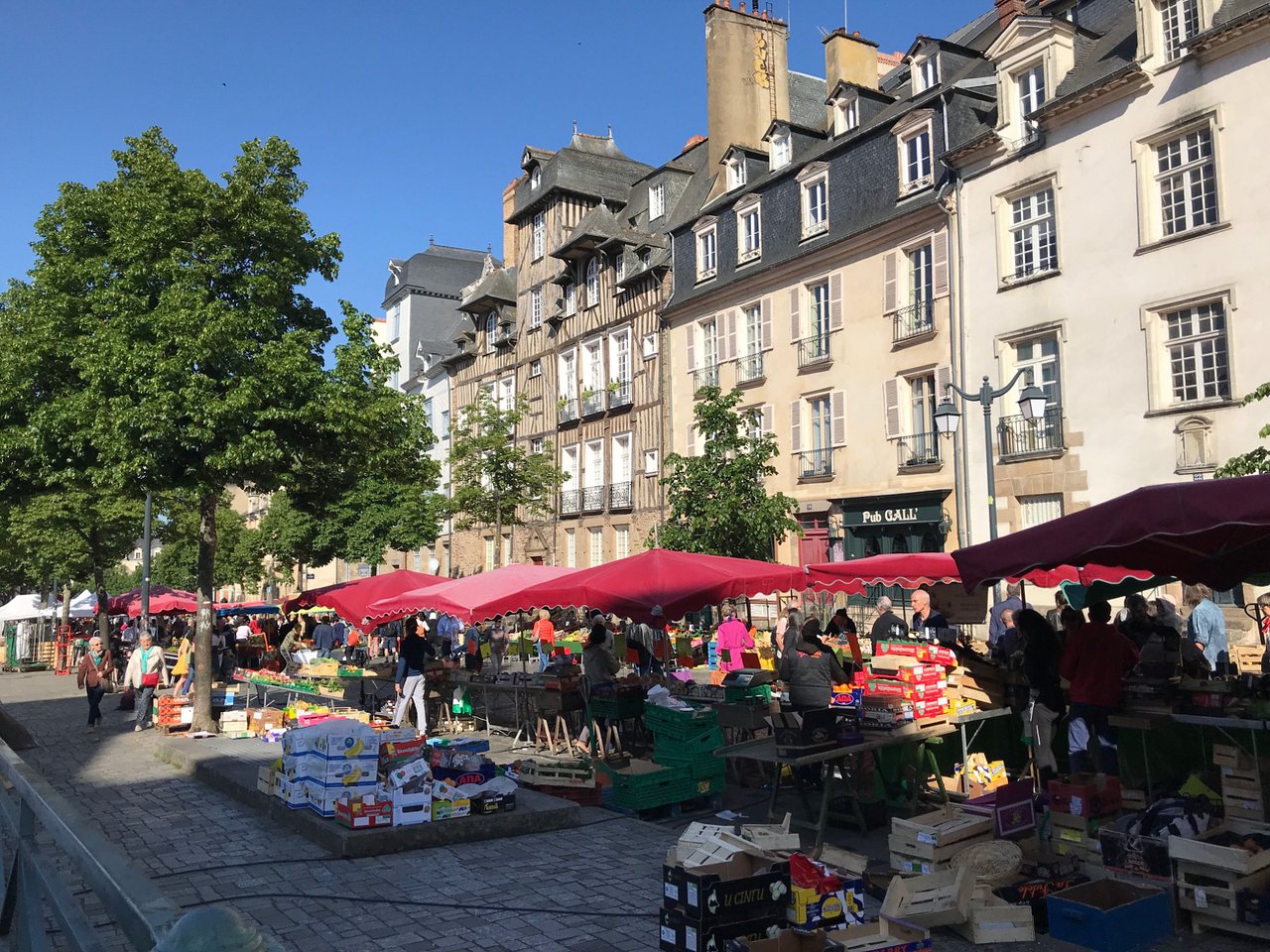 The
Place des Lices (below), where
jousting tournaments once took place, has been a
very well-attended Saturday marketplace since 1622
the second largest in France). Under dozens of red
tents you’ll find vendors specializing in wild
mushrooms, local cheeses and river and sea fish,
along with bargain clothes. (There’s a little
bistro on one end where you can get coffee and
breakfast before the market opens.)
The
Place des Lices (below), where
jousting tournaments once took place, has been a
very well-attended Saturday marketplace since 1622
the second largest in France). Under dozens of red
tents you’ll find vendors specializing in wild
mushrooms, local cheeses and river and sea fish,
along with bargain clothes. (There’s a little
bistro on one end where you can get coffee and
breakfast before the market opens.)
Also rebuilt with fidelity is the superb
17th century Palais du
Parlement de Bretagne, designed with a
mansard roof
by the architect who did Paris’s Palais du
Luxembourg. In 1994 a fast-moving fire damaged the
palace, but it is now back to its former majesty.
Other buildings of note, done in various styles,
are the half-timbered Maison des
Carmes on the Rue Vasselot, the splendid Lycée Émile
Zola (named after one of France’s greatest
authors), the baroque Toussaints
Church and the Palace of
Commerce.
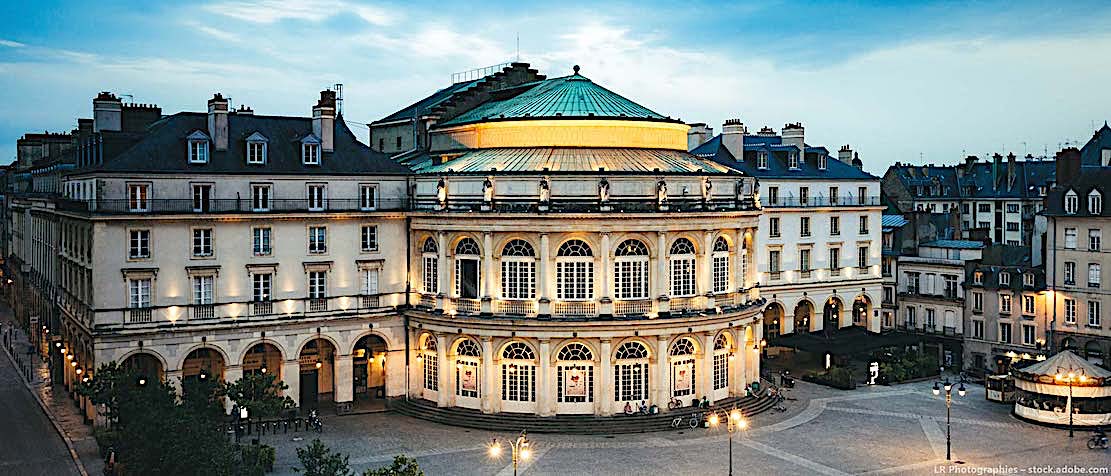 The
most spectacular building in Rennes is the 19th
century rounded 650-seat Opéra on the
Place de la Marie (left), the
smallest in France, adapted from Rome’s ancient
Theater of Marcellus, and it has a glorious Breton
ceiling fresco.
It was praised by Stendhal as being a
symbol of restorative culture after the great fire
had destroyed so much of the city. Rennes is also
home to several music venues and the L’Antipode
MJC art center.
The
most spectacular building in Rennes is the 19th
century rounded 650-seat Opéra on the
Place de la Marie (left), the
smallest in France, adapted from Rome’s ancient
Theater of Marcellus, and it has a glorious Breton
ceiling fresco.
It was praised by Stendhal as being a
symbol of restorative culture after the great fire
had destroyed so much of the city. Rennes is also
home to several music venues and the L’Antipode
MJC art center.
There are three highly regarded
universities in the city, two focusing on
technology (now the heart of Rennes’s economy), as
well as a Catholic University.
One of the antiquarian pleasures of Rennes
is to walk among the city’s remaining ramparts,
built from the 3rd to 12th centuries, once
providing broad views of the entire territory down
to the river, and to the east of the Old Town are
the 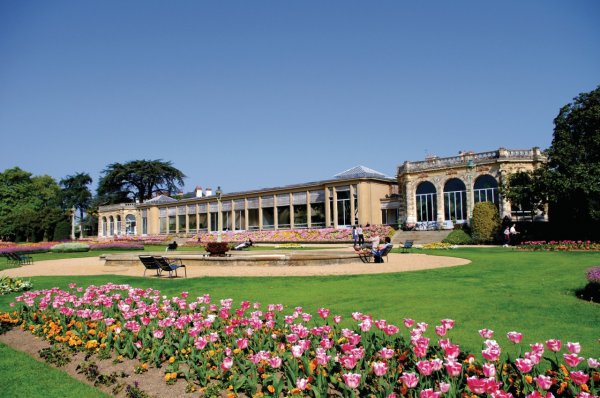 Thabor
Gardens (right), once an abbey
orchard, now laid out over 24 acres with a classic
French garden, an English garden, an aviary, a
children’s area and a botanical garden containing
3,000 species of plants.
Thabor
Gardens (right), once an abbey
orchard, now laid out over 24 acres with a classic
French garden, an English garden, an aviary, a
children’s area and a botanical garden containing
3,000 species of plants.
Rennes has
hotels of every stripe, and even for the best
hotels, prices rarely go above $200; others may
run for $100 or less. The Balthazar
Hotel & Spa is completely modern and as
good for tourists as for business travelers. Its
restaurant, La Table, is run by Parisian Chef
Michel Rostang (main courses run $26-$43). The
beautiful, elegantly appointed fairy
tale Château
d’Apigne (below),
set in a broad, 25-acre park just outside of town,
offers access to good fishing and its two dining
rooms, Les
Tourelles (meals about $46), are
among the finest restaurants in the region. A 16th
century building houses the Marnie &
Mister H BnB, and is very centrally located.
Breton food is hearty and homey, known for its
many savory and sweet galettes, made from
buckwheat flower and various fillings, the best
known being King’s Cake, as well as delicate, thin
crêpes and the
region’s famous waffles, all to be enjoyed
with the local cider.
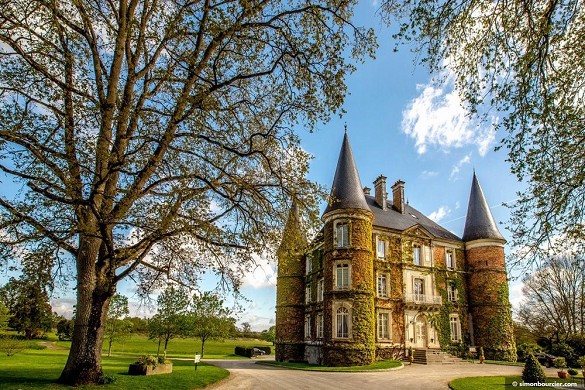 There
is a good range of bistros and fine dining rooms
(and one awful pizzeria downtown to be avoided). Ima,
which takes its name from the Japanese for “now,”
features cutting-edge cuisine (fixed price meals
$60-$115), while Racine (meals
$65-$85), with a Michelin star, under Chef
Virginie Giboire, draws on the regional provender
to create modern cooking within a bright, white
open kitchen space. For more traditional Breton
fare, try Le
Café du Port (meals about $50) and the
crêperie La
Saint-Georges.
There
is a good range of bistros and fine dining rooms
(and one awful pizzeria downtown to be avoided). Ima,
which takes its name from the Japanese for “now,”
features cutting-edge cuisine (fixed price meals
$60-$115), while Racine (meals
$65-$85), with a Michelin star, under Chef
Virginie Giboire, draws on the regional provender
to create modern cooking within a bright, white
open kitchen space. For more traditional Breton
fare, try Le
Café du Port (meals about $50) and the
crêperie La
Saint-Georges.
If you’ve run
out of pleasures in Rennes, head on down to the Quai
Saint-Cyr on the Embarcadero, where you can
rent an electric boat or kayak to sail the Vilaine
River and through the Ille-et-Rance Canal that
slowly meanders into the bucolic surroundings of
Brittany.
❖❖❖
LE
PAVILLON
212-662-1000
By John Mariani
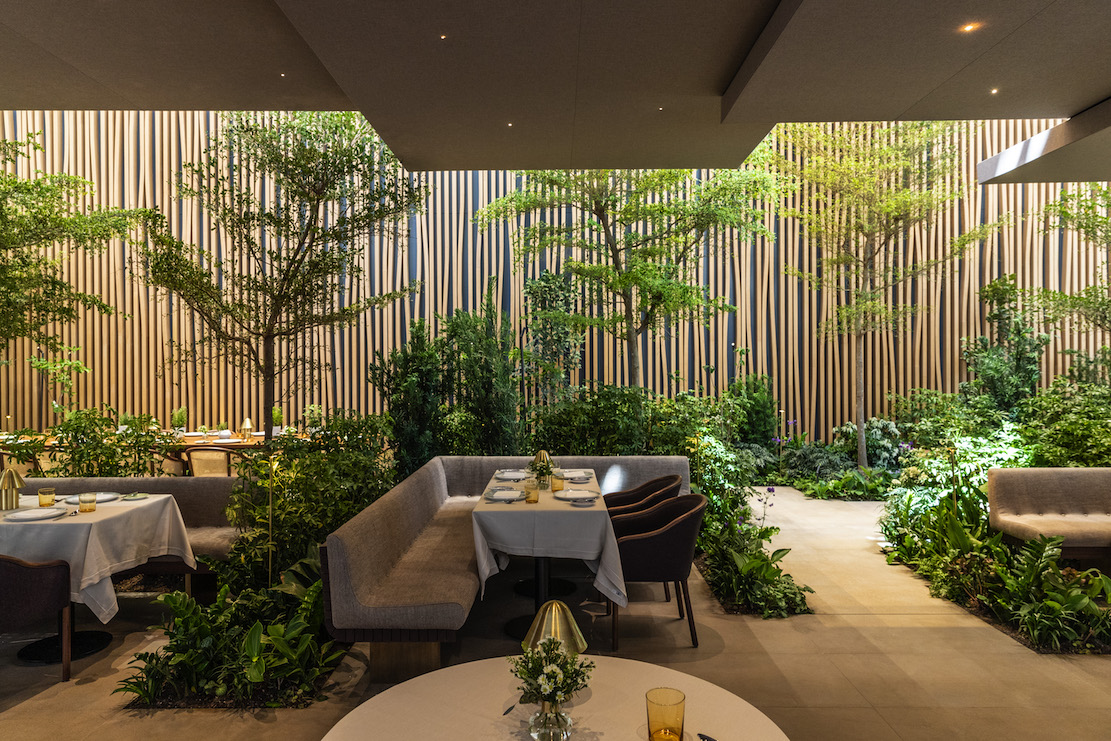
Food
pundits these days love nothing more than to
snub the idea that fine dining can possibly
survive in a world—make that country, as in
USA—where nobody wants to eat that way anymore.
And by all such myopic criteria the new Le
Pavillon, just by virtue of its archaic name,
should never have opened at all. Add to that its
location in the dead zone around Grand Central
Terminal and a menu built largely on French
cuisine, and such magpies trill about the odds
against such a restaurant, even one opened by
the redoubtable chef Daniel Boulud.
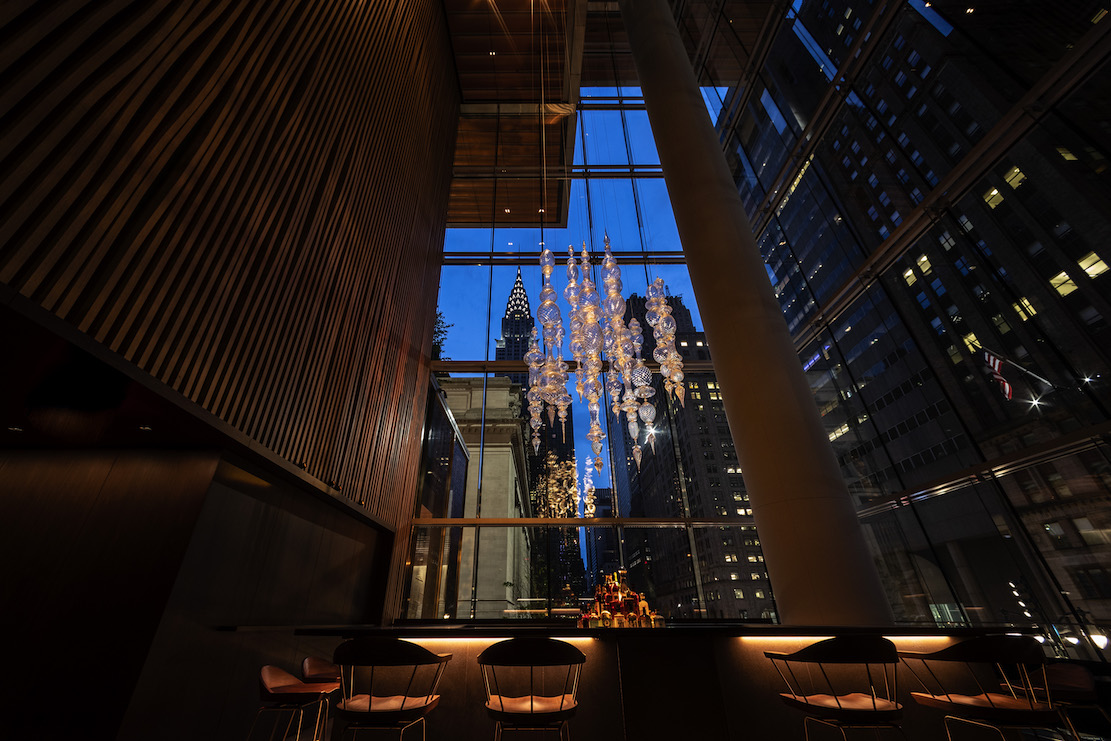 But what a restaurant it is! Located on the
second floor of a new midtown skyscraper, Le
Pavillon has the light, airiness of a first-class
airline lounge. Owing to its greenery, an indoor
garden, a wall of Brazilian slatting and a soaring
expanse of glass above it all, the dining room
seems to be outside without being closed in by the
city.
But what a restaurant it is! Located on the
second floor of a new midtown skyscraper, Le
Pavillon has the light, airiness of a first-class
airline lounge. Owing to its greenery, an indoor
garden, a wall of Brazilian slatting and a soaring
expanse of glass above it all, the dining room
seems to be outside without being closed in by the
city.
Oddly, it bears some resemblance to the
second incarnation of The Four Seasons restaurant
that failed so miserably in less than a year,
giving ammo to those who said such places were
dinosaurs. The restaurant is currently open only
for dinner five nights a week, and reservations
are already tough to get on short notice.
Le Pavillon takes its name from the
legendary French restaurant originally opened at
France’s Pavilion at the 1939 World’s Fair,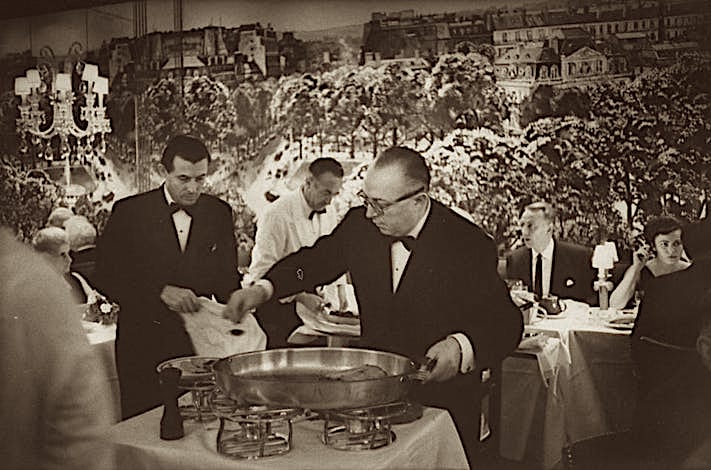 whose manager, Henri Soulé (right), after
the war transplanted it to 5 East 55th Street,
where he and his staff quite literally set the
standard for fine dining in America for decades to
come. Every French restaurant in New York copied
Le Pavillon (and often stole away its staff). Upon
Soulé’s death, Le Pavillon foundered and closed in
1971.
whose manager, Henri Soulé (right), after
the war transplanted it to 5 East 55th Street,
where he and his staff quite literally set the
standard for fine dining in America for decades to
come. Every French restaurant in New York copied
Le Pavillon (and often stole away its staff). Upon
Soulé’s death, Le Pavillon foundered and closed in
1971.
So Boulud’s resurrecting the name was a
signal that French cuisine was alive and well in
New York, though in décor and menu, totally
different from the stuffy and staid original Le
Pavillon. Those who accuse French cuisine of being
stuck in the classical past of Escoffier (as at La
Grenouille) have obviously never dined at modern
French restaurants in New York like Le Bernardin,
Gabriel Kreuther and Boulud’s own Restaurant
Daniel, where the food is as contemporary,
inventive and inspiring as any in American
gastronomy.
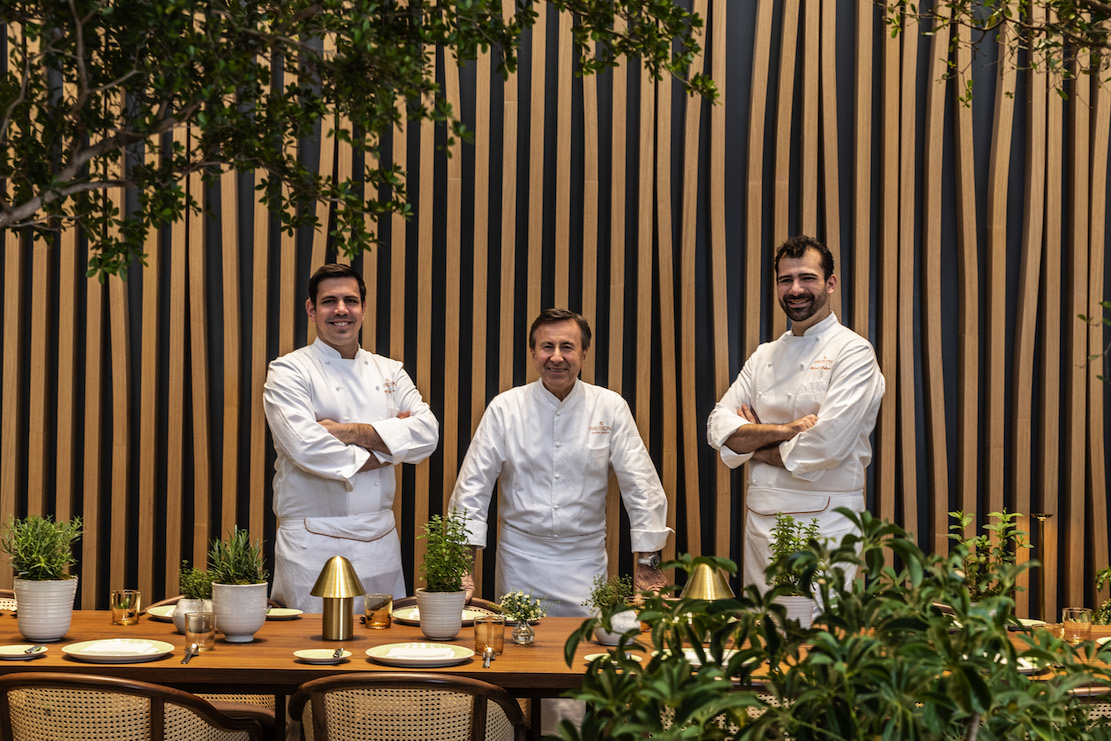 That
Le Pavillon’s menu differs so completely from all
those others is testament to the solid base of
French technique that allows for so much invention
without the ridiculous contortions of molecular
cuisine. This being 2021, Boulud, with
co-executive chefs Michael Balboni and William
Nacev, happily incorporates ideas from other
cuisines, too, as in his torchetti
pasta with Maryland jumbo lump crab, fennel confit
and fruity Jimmy Nardello peppers. He will also
make a chilled soup called corn velouté with
grilled cactus and Serrano cornbread and serve it
with a luscious soft foie gras parfait.
That
Le Pavillon’s menu differs so completely from all
those others is testament to the solid base of
French technique that allows for so much invention
without the ridiculous contortions of molecular
cuisine. This being 2021, Boulud, with
co-executive chefs Michael Balboni and William
Nacev, happily incorporates ideas from other
cuisines, too, as in his torchetti
pasta with Maryland jumbo lump crab, fennel confit
and fruity Jimmy Nardello peppers. He will also
make a chilled soup called corn velouté with
grilled cactus and Serrano cornbread and serve it
with a luscious soft foie gras parfait.
Guests
receive an amuse of caramelized
turnip puree with peaches. Among the appetizer there is
yellowfin tuna with film pollen and Niçoise socca crisp
with a creamy tonnato
(tuna) sauce. The oysters come from the Chesapeake
Bay and are called huitres Vanderbilt
with crunchy hazelnuts and a gratinéed parsley
seaweed crust.
Very fine sea scallops are dusted with
buckwheat and served with Cinco jotas Iberian ham
and colorful piperade just to give it a little
bite. Lotte, whose pulpy texture has never
thrilled me, took very well to a red wine glaze
with king trumpet mushrooms that gave it a woodsy
flavor and carrots and chewy black rice with a
butter-and-red wine sauce
matelote. 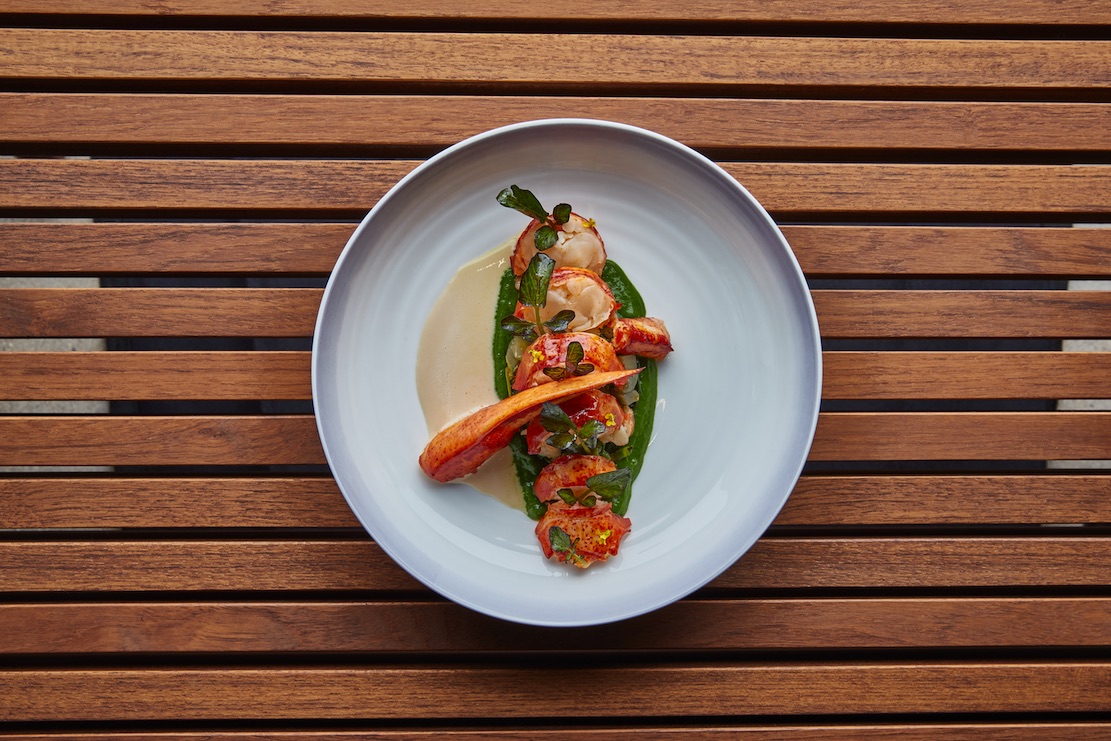 Lobster
is impeccably cooked to stay tender and briny,
with lovage, purple potatoes and a watercress
velouté. I eat a good deal of lamb, especially if
it’s from Colorado, and Le Pavillon’s most
certainly is and comes as a fat, well seared
double chop with sweet garlic, polenta, Swiss
chard and a touch of oregano jus.
Lobster
is impeccably cooked to stay tender and briny,
with lovage, purple potatoes and a watercress
velouté. I eat a good deal of lamb, especially if
it’s from Colorado, and Le Pavillon’s most
certainly is and comes as a fat, well seared
double chop with sweet garlic, polenta, Swiss
chard and a touch of oregano jus.
There is a welcome cheese selection, and
the night we dined they included Coupole, Comté,
Alma from Vermont and bleu d’Auvergne, served with
muscat grapes, glazed apricots and sourdough.
Executive pastry chef Sebastien Rouxel,
born in the Loire Valley, creates beautiful
desserts like a tart lemon curd with strawberries
and almonds, sable and the scent of verbena; milk
chocolate cremeux with praline croustillant and
hazelnut nougatine; and a grapefruit and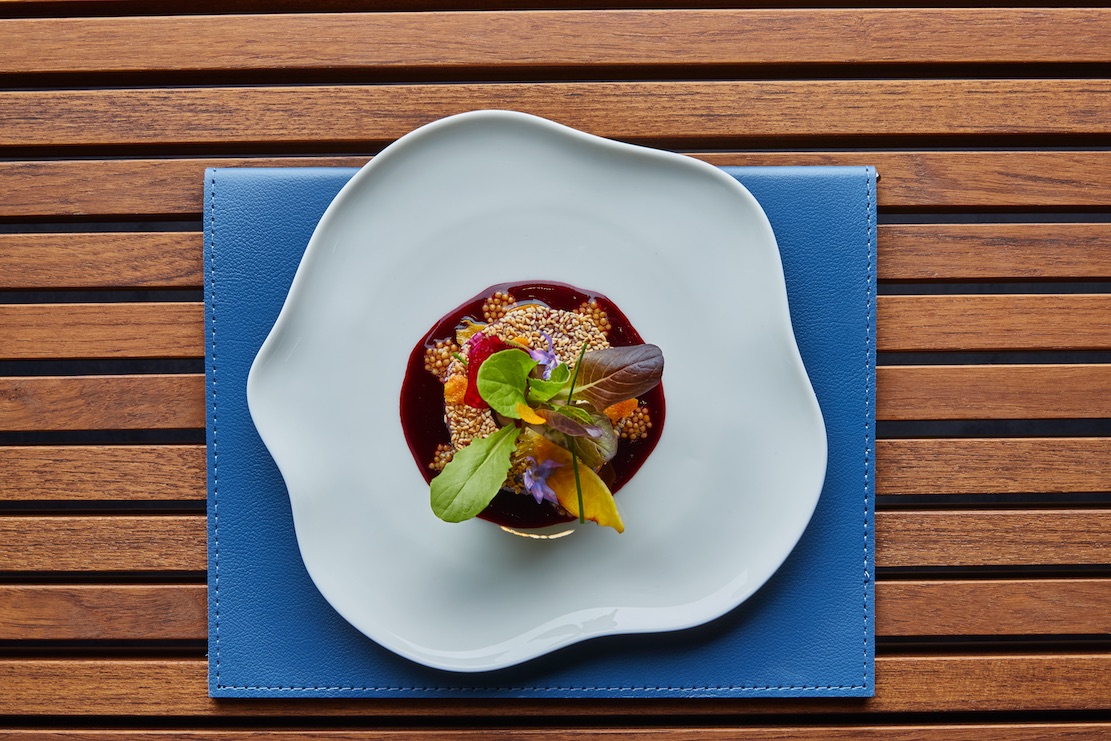 fennel vacherin with Campari lokum, a
confection of fruits and nuts more familiarly
called “Turkish delight.”
fennel vacherin with Campari lokum, a
confection of fruits and nuts more familiarly
called “Turkish delight.”
Head sommelier Blake Bernal stocks a wine
list 35
pages long, strong in every category. There are 25
very well selected wines by the glass, with
several under $20, but cocktails, at $21, are
high. Prices are quite fairly marked up: An
excellent 2018 Domaine Barat 1er Cru Vaillons
Chablis goes for $115, while at a wineshop it can
run $50.
Even at the high end, a Domaine le Flaive
Chevalier Montrachet 2018 is on the list at $2500,
in stores up to $1400. There are six half-bottles
and a good number of large format bottles.
I have not given dish prices because Le
Pavillon has a fixed price menu (mercifully with
very few supplements) of $125 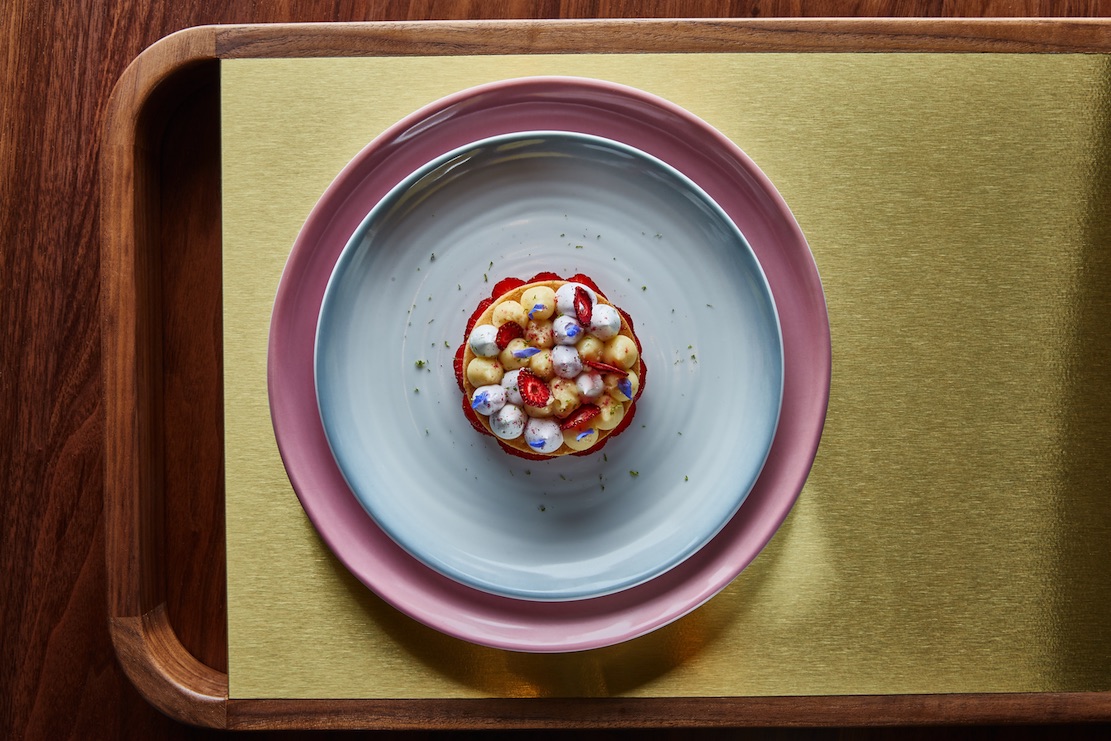 for
three courses, which is remarkable simply because
a côte de boeuf at the raucous Minetta Tavern
(without vegetables) will run you $81 per person
and at the wheezing Babbo, pasta with Australian
truffles goes for $85. There is, however, an à la
carte Bar Menu at Le Pavillon with a few dishes
from the dinner menu. There is also a six-course
seafood tasting at $195 and of vegetables at $155.
for
three courses, which is remarkable simply because
a côte de boeuf at the raucous Minetta Tavern
(without vegetables) will run you $81 per person
and at the wheezing Babbo, pasta with Australian
truffles goes for $85. There is, however, an à la
carte Bar Menu at Le Pavillon with a few dishes
from the dinner menu. There is also a six-course
seafood tasting at $195 and of vegetables at $155.
Le Pavillon is the kind of restaurant where
all women dress up, but the lack of even a
suggested dress guideline results in sightings of
slovenly men who look better fitted for Walmart
than Le Pavillon.
Ignore that and Le Pavillon
emerges as a restaurant of importance, in one
sense as a welcome back to fine dining and as a
completely new style of menu done with a youthful
panache you can sense comes from its young kitchen
staff overseen by Papa Daniel. Anyone who loves
fine cuisine and civilized dining cannot afford to
miss Le Pavillon, and, since it is so reasonably
priced, you can certainly afford a fine meal here.
Le Pavillon is open for dinner
Tues.-Sat.
CAPONE’S
GOLD

“How’d
you sleep?” asked Katie, pouring the coffee.
“Very, very well,” said David. “I let my
subconscious do all the work.”
“And what did your subconscious tell you?”
“That we should look further into Capone’s
boats, his yachts and his rumrunners. You know
about rumrunners?”
“I know what they are,” said Katie, “but
that’s all.”
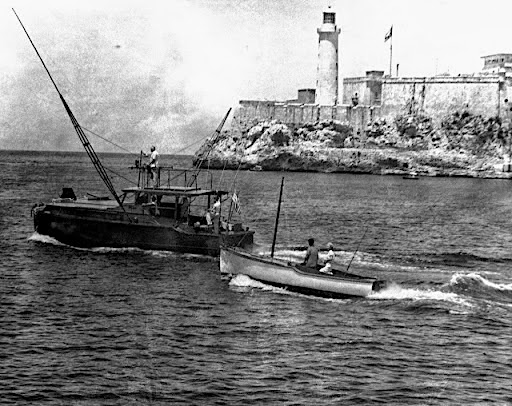 David
filled Katie in on what he knew, noting that
during Prohibition Capone had his own boats and
contracted others’ as well. He told
her about what the term the “Real McCoy” referred
to and how the Coast Guard was always at a
disadvantage in numbers and reliable info to
inflict much damage on the trade. After
Prohibition ended, bootlegging and rum running
took a lower rung on their priorities, and during
World War II a lot of the old Coast Guard boats
were refitted as sub-chasers and patrol boats.
David
filled Katie in on what he knew, noting that
during Prohibition Capone had his own boats and
contracted others’ as well. He told
her about what the term the “Real McCoy” referred
to and how the Coast Guard was always at a
disadvantage in numbers and reliable info to
inflict much damage on the trade. After
Prohibition ended, bootlegging and rum running
took a lower rung on their priorities, and during
World War II a lot of the old Coast Guard boats
were refitted as sub-chasers and patrol boats.
“That’s right,” said Katie. “Ernest
Hemingway was a sub-chaser for a while in his boat
named the Pilar (left). He wrote
about it in one of his novels, Islands in
the Stream.”
“Really? Never read that one. Anyway,
Capone owned at least two yachts, Spickler told
us, but he was referring to those tied up at the
Palm Island docks after the war. I’d like
to know where they came from and if Capone had
them built with special compartments and
additions. Spickler said one of the boats was a
retired rumrunner, which makes sense. And he
also said Capone like to sail to Bimini and Havana
after the 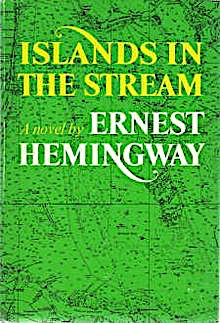 war. So what I’m
wondering is . . .”
war. So what I’m
wondering is . . .”
“Was he shipping the gold to one of those
places after the war?”
“Or before it, soon after he made the
heist. Y’know, I think we might have made a
mistake in thinking Capone couldn’t get the money
out of the country.” said David.
“How so?”
“Well, it’s not like we’ve exhausted the
possibilities for the gold being somewhere in the
U.S. Hell,
it could be anywhere.”
David believed that the longer it stayed
hidden in the U.S., the more likely it would have
been found, either by the feds or by Capone’s
enemies. Or,
if it hung around too long, it was probably stolen
by one of the few henchmen Capone would have
allowed to know its whereabouts. The fact that it
was supposedly just sitting there all those years,
with that reward money being offered, just didn’t
make any sense to David.
Barring
any evidence that Capone had all his henchmen
knocked off to keep them quiet, one of them had to
turn, especially after Capone died in 1947. By then,
all any one of them had to do was to contact the
feds, tell them where the gold was and collect
easy money without any further fear of Capone.
Katie cocked her head and said, “So, you’re
saying Capone somehow shipped all that bullion out
of the country?”
“Yes, and probably as quickly as he could.”
“But I remember you said it would be
impossible by plane, and loading it onto a ship
without being inspected by the feds would have
been very risky.”
“I know. Risky but not impossible. What
bothers me is that Capone obviously had access to
some of the stash from one of the original three
sites because he had that tableware made for his
family. But
that wouldn’t have amounted to very much. We’re
talking about robbing hundreds of ingots. And if
he could get those out of the country, they’d be
stored somewhere abroad where the feds couldn’t
get to it, maybe Europe. And when
World War Two started, it would be years before
the Allies set foot on the continent to even start
looking for it. So, Capone wouldn’t bother to tell
them where it was until after the war ended.”
“What about South America or Cuba?” asked
Katie.
“I thought about that,” said David, “and
Capone certainly had connections there. And
there were a lot of Italians who’d emigrated to
Argentina around the same time his own people
emigrated to the States. But I know next to
nothing about Argentina’s history. You’re the
history scholar.”
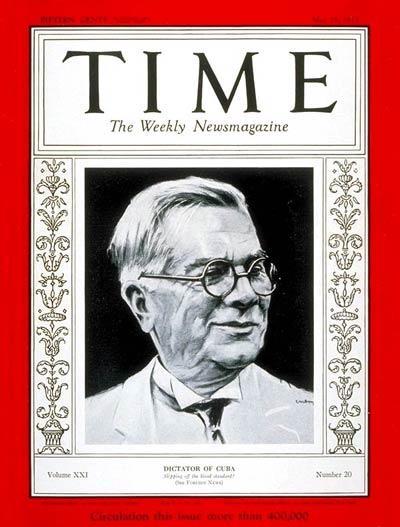 Katie made a face. “What I do recall was
that by the 1930s the political system in
Argentina was a mess and very unstable. One
military coup after another. Capone wouldn’t have
risked sending such a huge amount of gold to a
country whose next dictator might just claim the
stuff as his own.”
Katie made a face. “What I do recall was
that by the 1930s the political system in
Argentina was a mess and very unstable. One
military coup after another. Capone wouldn’t have
risked sending such a huge amount of gold to a
country whose next dictator might just claim the
stuff as his own.”
“And Cuba?”
“That I know more about. As a matter of
fact, I did a term paper on Cuban history in
college.”
“Really? Get a high mark?”
“An A-plus,” said Katie, brushing her nails
on her chest. “I think the professor had the hots
for me.”
“So what about Cuba?”
Katie explained that in the 1920s Cuba was
run by a totally corrupt president named Machado (left)
under the sponsorship of the American government.
“There was a lot of money to be made in hotels,
restaurants, and, of course, gambling and
prostitution,” she said, “but when the worldwide
Depression hit in 1929, the price of sugar, which
had always been the backbone of the Cuban economy,
dropped drastically and the citizens’ unrest led
to a general strike.”
She
explained that the American puppet Machado had the
local Communist Party on his side but the
military, seeing their own opportunity for power
and money, sided with the people and overthrew
Machado in 1933. Then, after infighting among the
generals, Batista (below) took over and was
a major figure in Cuba for the next 25 years
before being thrown out by Fidel Castro.
David was nodding. “So, Batista
was dictator throughout Capone’s incarceration?” 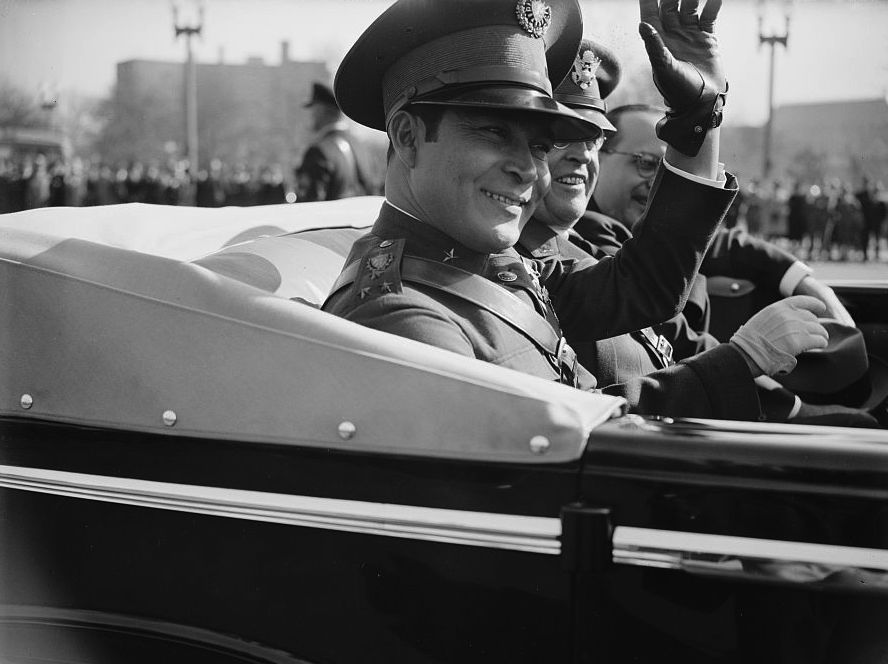
“To make a long story short, Battista was
voted out of office in the mid-forties, beaten by
another bum named Grau. Battista
didn’t come back to power until the 1950s, by
which time Capone was in the grave. So
through all that time, like you said about
Argentina, putting all that gold in the care of
government officials who were as corrupt as they
were power seekers would have been very risky for
Big Al. Plus
the fact that, if Capone eventually told the feds
the gold was in Cuba, good luck on them getting it
out of there by the late 1940s and ‘50s. I can’t
imagine it was just sitting in the central bank of
Havana.”
“True,” said David, “but all along you’ve
contended that Capone was really only trying to
embarrass the feds and collect the reward money.
If he just told them, `Hey, the gold’s in a vault
in Havana,’ he’d still get the reward money.”
“Yes, but he didn’t, did he? Unless he was
so bonkers by the end of the war that he literally
forgot where he stashed the gold, he most
certainly would have told the feds where it was by
then.”
“Makes sense,” said David, leaning back on
his chair. “So now all we have to do is figure out
where the hell else in the world Capone might have
shipped the gold and how he did it.”
“Well, there’s still Bimini and the
Bahamas. That’s
where the rumrunner boats might come in. Otherwise,
I’d say we concentrate on either Canada or Europe. Remember
by the late 1930s the Europeans were trying to
ship their gold to the U.S. for safekeeping.”
“Meaning, if Capone shipped his the other
way, back to Europe, it would be worth a helluva
lot more.”
“Exactly,” said Katie. “Plus I
don’t think shipping it to Canada would have been
any different than keeping it in the U.S. Someone
in the Canadian bootleg mobs knowing its
whereabouts would have talked.”
“Katie,” said David. “I’ve got to hand it
to you: you’ve narrowed our search down to, what,
about thirty countries!”
“Well, if you count the post-war Soviet
Union, probably more.”
“I’d eliminate them right off the bat.”
“Why?”
.png) David
explained that mobsters hated and feared
communists as much as they did the feds. It was
one of the reasons the Mafia worked with the
C.I.A. to oust Castro (left). Commies
are not good for business. Capone
always thought of himself as a man whose success
was due entirely to good old American capitalism,
and communism would have prevented that. He
probably also figured communists weren’t easy to
bribe.
David
explained that mobsters hated and feared
communists as much as they did the feds. It was
one of the reasons the Mafia worked with the
C.I.A. to oust Castro (left). Commies
are not good for business. Capone
always thought of himself as a man whose success
was due entirely to good old American capitalism,
and communism would have prevented that. He
probably also figured communists weren’t easy to
bribe.
“I don’t know how he felt about Joe
Stalin,” said David, “but if he’d heard anything
about the mass slaughters in Russia in the ‘20s
and ‘30s, Capone could only have believed he’d be
first in line for execution if the communists took
over the U.S.”
“My God, we’re narrowing this down fast!”
said Katie.
“You have an atlas around here?” David
asked.
Katie said she thought she did and with a
little rummaging found one. “It’s not up to date
but . . .”
“It only needs to be up to date as of the
1940s.”
They opened the book, copyrighted 1970, to
a general map of
nations bordering the Atlantic Ocean, the
countries in a wide variety of faded colors. There
were a lot of them.
“Sheesh!” said David, “That’s a lot of
territory.”
“Let’s see if they have any historical maps
of earlier periods,” said Katie, flipping to the
table of contents.
“Bingo! Look, there’s a map of Europe after
World War I and another during World War II. Just
the periods we’re looking for.”
They perused both maps carefully,
discarding Scandinavia and eastern Europe as
beyond Capone’s consideration. Certainly
not
Great Britain or France. Greece too far. Spain was
going through a civil war with communists until
1939. 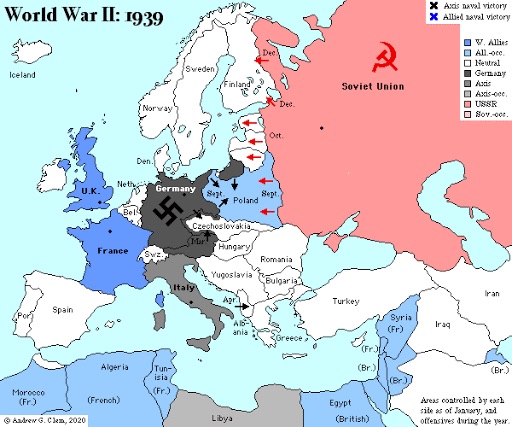
“We have to think which countries Capone
would have had connections with at the time,” said
David. “He
was a bootlegger first and foremost, and he
smuggled in booze mostly from Canada, which we’ve
eliminated. I assume he brought in wine, too.”
“I’m sure he did,” said Katie, “but, if
they were French wines, they
probably came through their territories in the
Caribbean, maybe Martinique or St. Bart’s. I
suggest we do some more research on Al’s rum
running operations and boats. Who
keeps records on boats?”
“You mean, assuming they’re registered?”
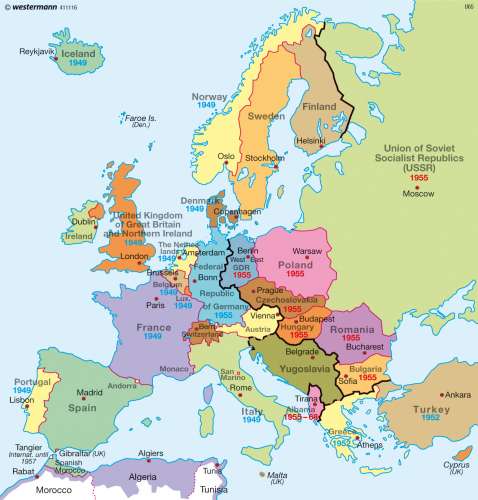 “Yes, or if they were not, there must be
records of the boats the Coast Guard confiscated,
auctioned and sank.”
“Yes, or if they were not, there must be
records of the boats the Coast Guard confiscated,
auctioned and sank.”
“Let me call a guy I know at Port
Authority,” said David. “He may
know.”
A half hour later David had what he’d asked
for: the New York Yacht Club keeps records of all
American yachts and most foreign ones; Mystic
Seaport in the Connecticut town of the same name
has a renowned collection of historic boat plans
and photos; and the U.S. Naval Institute in
Annapolis, Maryland, has extraordinary resources
on anything having to do with naval and maritime
history, including hundreds of thousands of
photos.
“So how do we split these up?” asked David.
“Well, the New York Yacht Club is right
down on West 44th Street,” said Katie. “Both of
us can visit that.
Mystic is closer to you, and I can shoot
down to Annapolis on Amtrak. Okay
with you?”
“Sure, you want to go to the Yacht Club
together?”
“No time like the present.
Let’s go.”
© John Mariani, 2015
❖❖❖
IN THE SUMMER MARKET
By John Mariani

The
biggest players in the spirits market, both brown
and white, are getting more and more competitive
by bringing more and more new concepts into what
has always been a very traditional industry. For
even though sales declined dramatically in bars
and restaurants during Covid, American brown
spirits like Bourbon, Tennessee whiskey and Rye
are growing significantly in the United State and
abroad, bought at liquor stores. According to
Distilled Spirits Council, bourbon, Tennessee
whiskey and rye whiskey sales rose by 8.2%, or
$327 million, in 2020. American Rye—once almost
ignored—recorded an increase of 15.9% in 1.1
million 9-liter cases in 2018 in the U.S. and is
growing fast.
The American market is showing enormous
interest in high-end Japanese whiskies, which, by
law, cannot be called Scotch, even if made with
the same ingredients of barley malted by peat.
The market studied is dominated by players
like Diageo PLC, Pernod Ricard, Suntory Holdings
Limited, Bacardi Limited, and Sazerac and Company
Inc., along with E & J Gallo Winery, The
Brown–Forman Corporation and others. But how do you
change a product based on specific flavor profiles
dating back decades, even centuries, without
intimidating regular drinkers? In some cases, it’s
the same old booze in brand new bottles, as Powers
did with its Irish whiskey in 2020, and Cognac
producers are doing with their brandies to be sold
in gift-wrapped packages. There’s a lot more
smokiness being added, not to mention spices and
fruit flavors, and there’s a great deal of marketing
over what spirit was aged in what kind of wooden
barrel for how long, even if blended whiskies don’t
get any better once bottled.
So the rage for novelty has engaged a young
crowd looking for new flavor profiles with florid
label descriptions that sometimes tell tales in
order to bolster pedigree. Still, there’s a lot of
excellent and distinctive new spirits in the market.
Here are some I’m impressed with these days.
 Arran Single Malt Whisky ($40)—Believe what you wish
about the efficacy of how “Scottish rainwater at
Loch Na Davie in the hills above the distillery
cascades through six waterfalls, each none purifying
the water further” (on the Isle of Arran off
Scotland’s western coast), but the limited editions
of these single malts include one as cask strength
($90), another a 10-year-old “non-chilled filtered”
and un-colored by caramel at 46% ($68), a Barrel
Reserve at 43% in American oak ($69) and another
aged in old Sauternes casks ($90).
Arran Single Malt Whisky ($40)—Believe what you wish
about the efficacy of how “Scottish rainwater at
Loch Na Davie in the hills above the distillery
cascades through six waterfalls, each none purifying
the water further” (on the Isle of Arran off
Scotland’s western coast), but the limited editions
of these single malts include one as cask strength
($90), another a 10-year-old “non-chilled filtered”
and un-colored by caramel at 46% ($68), a Barrel
Reserve at 43% in American oak ($69) and another
aged in old Sauternes casks ($90).
The Glenrothes Speyside
Single Malt Scotch 18 Years Old ($160) —This was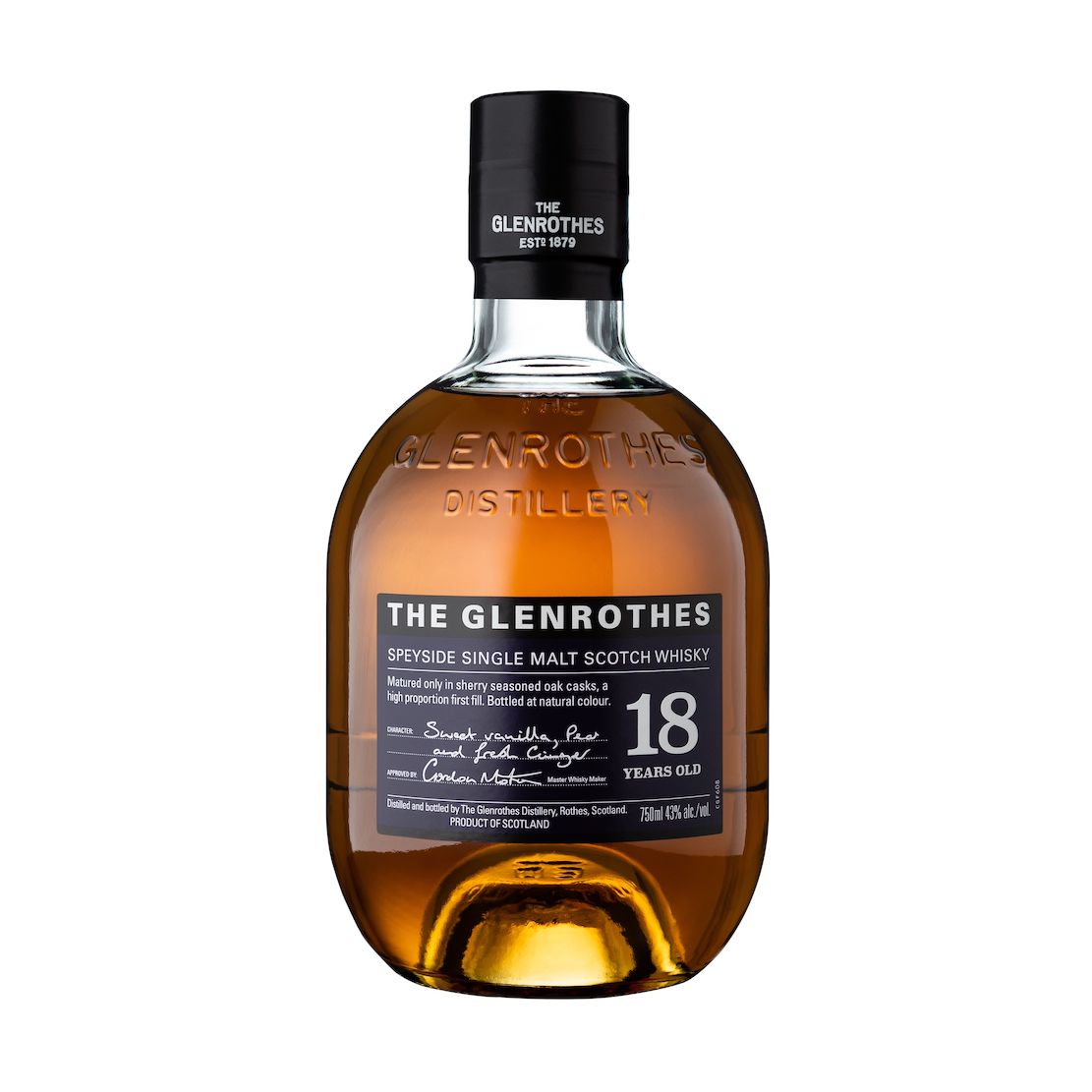 named the Best Single Malt in the Ultimate Spirits
Challenge 2020, aged in sherry casks that have been
matured at the Speyside distillery, which has been
around since 1789. Reference to “18 years” means
that the youngest Scotch in the bottle dates to that
year, blended with older whiskies. Glenrothes also
make a 12 Year Old ($60) that has become their basic
house style; a Whisky Maker’s Cut ($80), with 48.8%
alcohol, using first fill sherry seasoned casks,
bottled at the whisky maker's preferred strength.
Creamy vanilla, orange peel and nutmeg taste;
and a 25
Year old ($500), with more woody notes.
named the Best Single Malt in the Ultimate Spirits
Challenge 2020, aged in sherry casks that have been
matured at the Speyside distillery, which has been
around since 1789. Reference to “18 years” means
that the youngest Scotch in the bottle dates to that
year, blended with older whiskies. Glenrothes also
make a 12 Year Old ($60) that has become their basic
house style; a Whisky Maker’s Cut ($80), with 48.8%
alcohol, using first fill sherry seasoned casks,
bottled at the whisky maker's preferred strength.
Creamy vanilla, orange peel and nutmeg taste;
and a 25
Year old ($500), with more woody notes.
High Plains Rye Straight
Rye Whiskey ($55)—Just hit the market,
the creation of Louisville Master Distiller Jim
Rutledge (formerly at Four Roses) at the J. W.
Rutledge Distillery. They blend five straight rye
whiskeys from four states–Indiana, Kentucky, Ohio
and New York, each
varying from 51% rye grain to 100% rye, plus
a specific yeast strain and 48.5% alcohol. It’s a
fine combination of mellowness with a pleasing
peppery bite and shows how rye differs from bourbon
(made with corn).
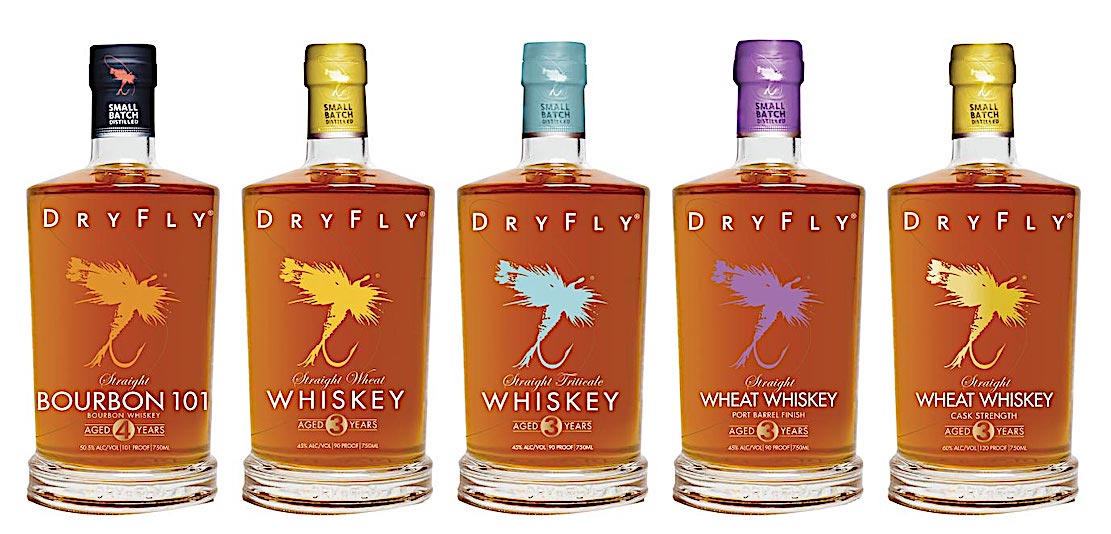 Dry Fly Distilling ($40)—Coming out of
Spokane, Washington, Dry Fly president and founder
Don Poffenroth built a new 24,000-sq.-ft. facility
to increase production capacity to 75,000 and more. The story
goes that Poffenroth and a good friend were fishing
when they hatched an idea to find a way to share
their mutual love of hand-crafted spirits and the
natural beauty and purity of the Northwest. Grain is
sourced from family farms located within 30 miles of
the distillery.
Dry Fly Distilling ($40)—Coming out of
Spokane, Washington, Dry Fly president and founder
Don Poffenroth built a new 24,000-sq.-ft. facility
to increase production capacity to 75,000 and more. The story
goes that Poffenroth and a good friend were fishing
when they hatched an idea to find a way to share
their mutual love of hand-crafted spirits and the
natural beauty and purity of the Northwest. Grain is
sourced from family farms located within 30 miles of
the distillery.
James Ownby Reserve
Tennessee Straight Bourbon Whiskey ($40)—Distilled at the Ole
Smoky Distillery (which made its name for moonshine),
this bourbon is 47% alcohol, aged in American virgin
charred oak barrels and filtered via the Lincoln
County Process, whereby the spirits pass through
sugar maple charcoal before aging. Its power is
evident but its complexity is impressive, with lots
of fruit and caramel notes.
Peerless Kentucky
Straight Bourbon ($69) and Peerless
Kentucky Straight Rye ($69) are both small
batch whiskies and very smooth, with no real burn in
the rye and lots of vanilla and citrus in both.
Excellent for sipping, even if cut with a touch.jpg) of water.
of water.
Hirsch The Horizon
Straight Bourbon Whiskey ($40)—Like many producers,
Hirsch buys from others’ stocks, and its rectangular
bottle is a beauty. The 46% alcohol has medium heft,
and it’s quite spicy and has a pleasing sweet
undertone. It has a creamy texture and a touch of
leather in the finish. Very well priced for this
quality.
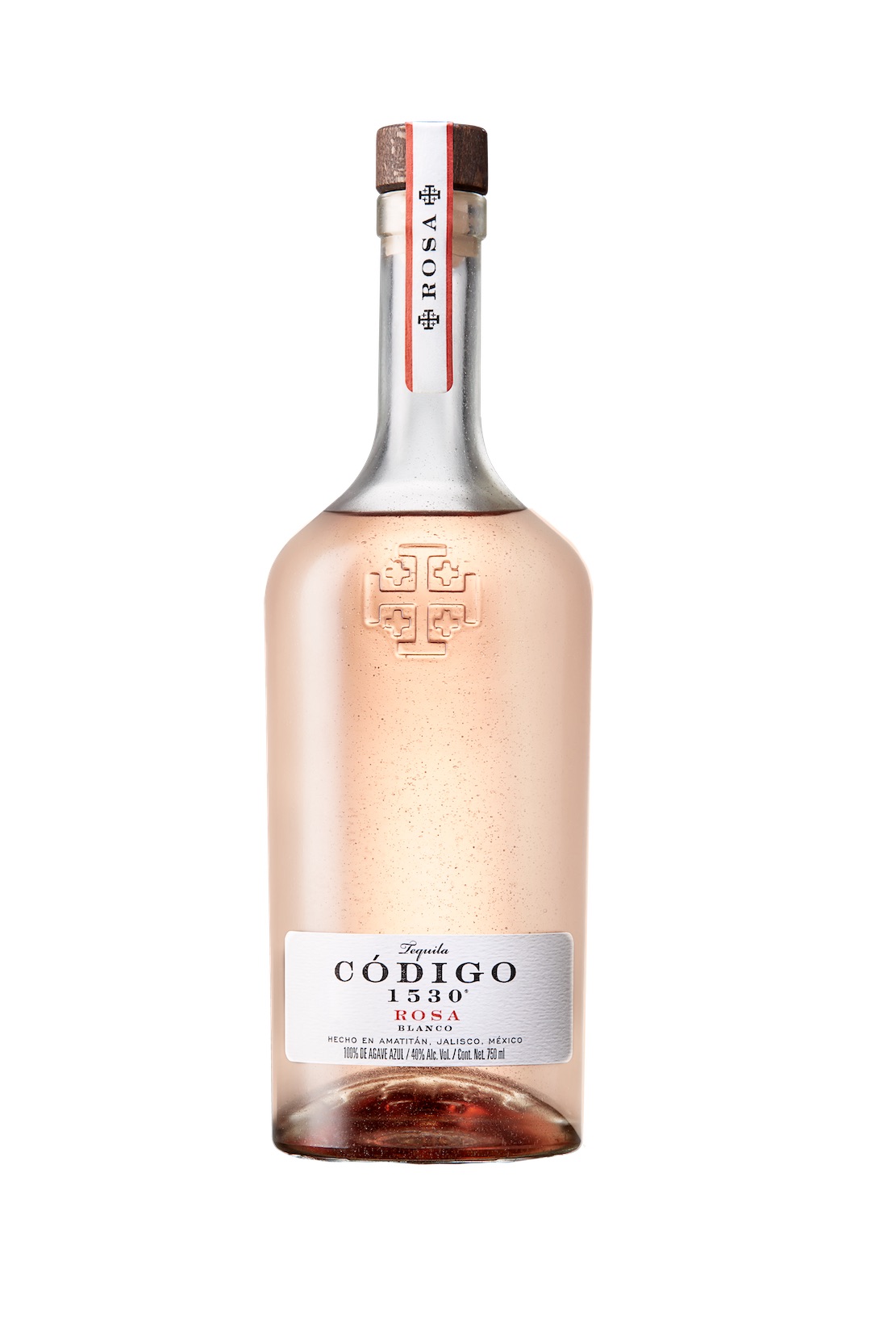
Código 1530 Rosa ($65)— Código tequila has
its own distillery in Amatitán and grows some of its
own agave, and supposedly utilizes a secret family
recipe. It actually does have a very pale rose color
obtained from aging in French oak, and investor
George Strait even wrote a song about it. It has a
wonderful aroma and, as a blanco,
gives a margarita a first-rate base, but it can be
drunk on the rocks as an aperitif.
❖❖❖
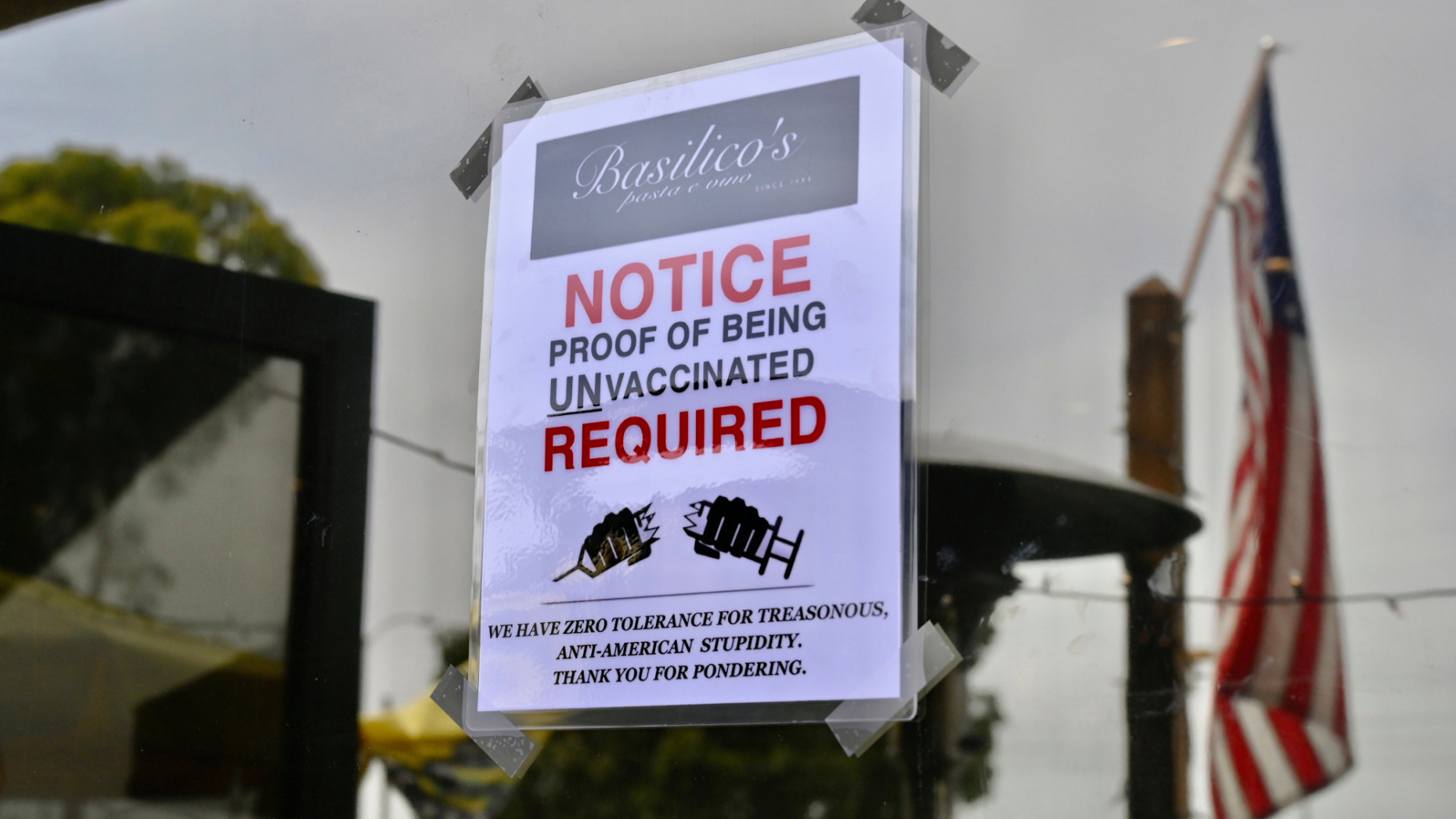
ALSO, PLEASE CHECK YOUR BRAINS AT THE DOOR
A restaurant in Southern California town of Huntington Beach is demanding that customers prove they’re un-vaccinated against the coronavirus as a protest against public health protections. Basilico’s Pasta e Vino Italian restaurant said, “We have zero tolerance for treasonous, anti-American stupidity.”
Any of John Mariani's books below may be ordered from amazon.com.
 The Hound in Heaven
(21st Century Lion Books) is a novella, and
for anyone who loves dogs, Christmas, romance,
inspiration, even the supernatural, I hope you'll find
this to be a treasured favorite. The story
concerns how, after a New England teacher, his wife and
their two daughters adopt a stray puppy found in their
barn in northern Maine, their lives seem full of promise.
But when tragedy strikes, their wonderful dog Lazarus and
the spirit of Christmas are the only things that may bring
his master back from the edge of despair.
The Hound in Heaven
(21st Century Lion Books) is a novella, and
for anyone who loves dogs, Christmas, romance,
inspiration, even the supernatural, I hope you'll find
this to be a treasured favorite. The story
concerns how, after a New England teacher, his wife and
their two daughters adopt a stray puppy found in their
barn in northern Maine, their lives seem full of promise.
But when tragedy strikes, their wonderful dog Lazarus and
the spirit of Christmas are the only things that may bring
his master back from the edge of despair. WATCH THE VIDEO!
“What a huge surprise turn this story took! I was completely stunned! I truly enjoyed this book and its message.” – Actress Ali MacGraw
“He had me at Page One. The amount of heart, human insight, soul searching, and deft literary strength that John Mariani pours into this airtight novella is vertigo-inducing. Perhaps ‘wow’ would be the best comment.” – James Dalessandro, author of Bohemian Heart and 1906.
“John Mariani’s Hound in Heaven starts with a well-painted portrayal of an American family, along with the requisite dog. A surprise event flips the action of the novel and captures us for a voyage leading to a hopeful and heart-warming message. A page turning, one sitting read, it’s the perfect antidote for the winter and promotion of holiday celebration.” – Ann Pearlman, author of The Christmas Cookie Club and A Gift for my Sister.
“John Mariani’s concise, achingly beautiful novella pulls a literary rabbit out of a hat – a mash-up of the cosmic and the intimate, the tragic and the heart-warming – a Christmas tale for all ages, and all faiths. Read it to your children, read it to yourself… but read it. Early and often. Highly recommended.” – Jay Bonansinga, New York Times bestselling author of Pinkerton’s War, The Sinking of The Eastland, and The Walking Dead: The Road To Woodbury.
“Amazing things happen when you open your heart to an animal. The Hound in Heaven delivers a powerful story of healing that is forged in the spiritual relationship between a man and his best friend. The book brings a message of hope that can enrich our images of family, love, and loss.” – Dr. Barbara Royal, author of The Royal Treatment.
 |
The Encyclopedia of American Food and Drink by John F. Mariani (Bloomsbury USA, $35) Modesty forbids me to praise my own new book, but let me proudly say that it is an extensive revision of the 4th edition that appeared more than a decade ago, before locavores, molecular cuisine, modernist cuisine, the Food Network and so much more, now included. Word origins have been completely updated, as have per capita consumption and production stats. Most important, for the first time since publication in the 1980s, the book includes more than 100 biographies of Americans who have changed the way we cook, eat and drink -- from Fannie Farmer and Julia Child to Robert Mondavi and Thomas Keller. "This book is amazing! It has entries for everything from `abalone' to `zwieback,' plus more than 500 recipes for classic American dishes and drinks."--Devra First, The Boston Globe. "Much needed in any kitchen library."--Bon Appetit. |
"Eating Italian will never be the same after reading John Mariani's entertaining and savory gastronomical history of the cuisine of Italy and how it won over appetites worldwide. . . . This book is such a tasteful narrative that it will literally make you hungry for Italian food and arouse your appetite for gastronomical history."--Don Oldenburg, USA Today. "Italian
restaurants--some good, some glitzy--far
outnumber their French rivals. Many of
these establishments are zestfully described
in How Italian Food Conquered the World, an
entertaining and fact-filled chronicle by
food-and-wine correspondent John F.
Mariani."--Aram Bakshian Jr., Wall Street
Journal.
"Equal parts
history, sociology, gastronomy, and just
plain fun, How Italian Food Conquered the
World tells the captivating and delicious
story of the (let's face it) everybody's
favorite cuisine with clarity, verve and
more than one surprise."--Colman Andrews,
editorial director of The Daily
Meal.com. "A fantastic and fascinating
read, covering everything from the influence
of Venice's spice trade to the impact of
Italian immigrants in America and the
evolution of alta cucina. This book will
serve as a terrific resource to anyone
interested in the real story of Italian
food."--Mary Ann Esposito, host of PBS-TV's
Ciao
Italia. "John Mariani has written the
definitive history of how Italians won their
way into our hearts, minds, and
stomachs. It's a story of pleasure over
pomp and taste over technique."--Danny Meyer,
owner of NYC restaurants Union Square
Cafe, The Modern, and Maialino.
|
 |
 |
 |
 |
 |
 |
 Everett Potter's Travel Report:
Everett Potter's Travel Report: 
 Eating Las
Vegas JOHN CURTAS has been covering
the Las Vegas food and restaurant scene
since 1995. He is the co-author of EATING LAS
VEGAS – The 50 Essential Restaurants (as
well as the author of the Eating Las
Vegas web site: www.eatinglasvegas.
He can also be seen every Friday morning as
the “resident foodie” for Wake Up With the
Wagners on KSNV TV (NBC) Channel 3 in
Las Vegas.
Eating Las
Vegas JOHN CURTAS has been covering
the Las Vegas food and restaurant scene
since 1995. He is the co-author of EATING LAS
VEGAS – The 50 Essential Restaurants (as
well as the author of the Eating Las
Vegas web site: www.eatinglasvegas.
He can also be seen every Friday morning as
the “resident foodie” for Wake Up With the
Wagners on KSNV TV (NBC) Channel 3 in
Las Vegas.
MARIANI'S VIRTUAL GOURMET
NEWSLETTER is published weekly. Publisher: John Mariani. Editor: Walter Bagley. Contributing Writers: Christopher Mariani,
Robert Mariani, Misha Mariani, John A. Curtas, Gerry Dawes, Geoff Kalish,
and Brian Freedman. Contributing
Photographer: Galina Dargery. Technical
Advisor: Gerry
McLoughlin.
If you wish to subscribe to this
newsletter, please click here: http://www.johnmariani.com/subscribe/index.html
© copyright John Mariani 2021
